Ear piercing is a timeless form of self-expression‚ offering countless styles to suit every personality. From the classic lobe to trendy cartilage piercings‚ this practice has evolved into a popular way to accessorize. With societal norms shifting‚ piercings are now celebrated as a form of personal art. Whether for aesthetics or cultural significance‚ ear piercing allows individuals to curate their look with precision. The process‚ when done professionally‚ ensures safety and comfort‚ making it accessible to everyone.
Explore the world of ear piercing and discover how it can enhance your unique style while embracing its rich history and modern appeal.

Types of Ear Piercings
Ear piercings offer a wide variety of options‚ catering to different preferences‚ styles‚ and pain tolerances. From subtle and elegant to bold and eye-catching‚ there’s a piercing for everyone. The most common types include the lobe‚ helix‚ tragus‚ daith‚ rook‚ conch‚ and transverse lobe piercings‚ each with unique characteristics and placement.
The lobe piercing is the most traditional and least painful‚ located at the soft tissue of the ear’s lower section. It’s a classic choice for both men and women and is often the first piercing people get. The helix piercing‚ positioned on the upper cartilage of the ear‚ offers a sleek and modern look‚ perfect for those who want a minimalist aesthetic.
The tragus piercing‚ located on the small flap of skin in front of the ear canal‚ is a trendy option that adds a delicate touch. Similarly‚ the daith piercing‚ situated in the inner fold of the ear‚ has gained popularity for its unique appearance and is often paired with small hoops or studs. The rook piercing‚ positioned in the upper cartilage between the helix and conch‚ is ideal for those seeking a more adventurous style.
The conch piercing‚ located in the shell-shaped area of the ear‚ is a versatile option that works well with a variety of jewelry styles. For those who prefer a more dramatic look‚ the transverse lobe piercing‚ which goes horizontally through the earlobe‚ is a standout choice. The industrial piercing‚ involving two holes connected by a single piece of jewelry‚ is perfect for bold fashion statements.
Other popular options include the snug piercing‚ located in the inner rim of the ear‚ and the forward helix piercing‚ positioned closer to the face for a striking effect. Each type of piercing offers a unique way to express personal style‚ making ear piercings a customizable and enduring form of self-expression.
With so many options available‚ individuals can choose piercings that align with their preferences‚ whether they prefer understated elegance or bold statement pieces. The diversity of ear piercings ensures there’s something for every taste and lifestyle.

The Piercing Process
Getting an ear piercing is a straightforward process when done by a professional‚ but it’s important to understand what happens during the procedure to ensure a smooth experience. The process typically begins with a consultation to determine the desired placement and type of piercing. A reputable piercer will use high-quality equipment and follow proper sanitation protocols to minimize risks and ensure safety.
Once the placement is decided‚ the piercer will mark the area with a marker to ensure accuracy. This step allows the client to review and approve the position before the piercing takes place. The actual piercing involves using a sterile needle or piercing gun‚ depending on the type of piercing and the piercer’s preference. The procedure is usually quick‚ with most piercings taking only a few seconds to complete.
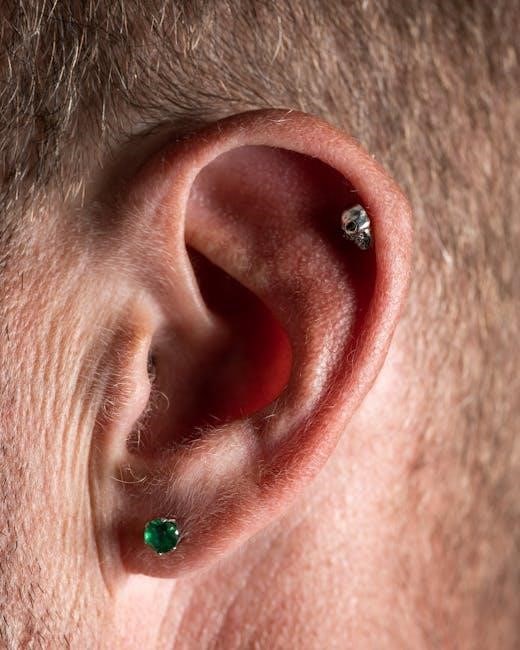
After the piercing‚ the piercer will insert the initial jewelry‚ which is typically designed to facilitate healing. This jewelry is usually made from hypoallergenic materials like surgical stainless steel or titanium to reduce the risk of allergic reactions. The piercer will also provide aftercare instructions‚ which are crucial for promoting healing and preventing complications.
The piercing process should always be performed in a clean and hygienic environment. Reputable studios use autoclaves to sterilize equipment and follow proper handwashing procedures to ensure client safety. While the process is generally safe‚ it’s essential to choose a licensed and experienced piercer to minimize the risk of complications.
Understanding the piercing process can help alleviate anxiety and ensure a positive experience. By knowing what to expect‚ individuals can feel more confident and prepared as they embark on their piercing journey.

Choosing the Right Jewelry
Selecting the right jewelry for your ear piercing is a crucial decision that impacts both aesthetics and healing. The initial jewelry chosen should prioritize comfort‚ quality‚ and suitability for the piercing type. For new piercings‚ it’s essential to opt for hypoallergenic materials like surgical stainless steel‚ titanium‚ or 14k gold‚ as these reduce the risk of allergic reactions and promote healing.
Studs and labret jewelry are often recommended for initial piercings due to their simplicity and minimal irritation. Hoops and rings are popular for healed piercings‚ as they offer a stylish‚ versatile look. However‚ hoops should be avoided during the healing process‚ as they can catch on clothing or bedding‚ potentially causing discomfort or complications.
Jewelry size and fit are equally important. A piece that is too tight may restrict blood flow‚ while one that is too loose can increase the risk of catching or losing the jewelry. A professional piercer can help determine the appropriate size for your specific piercing‚ ensuring a comfortable and secure fit.
When selecting jewelry for healed piercings‚ personal style and creativity come into play. Consider the thickness of the jewelry‚ as thicker gauges may require a different type of piercing. Decorative ends‚ charms‚ and threaders can add flair‚ but it’s important to ensure they are securely fastened to avoid loss.
Cost is another factor to consider. While high-quality jewelry may seem expensive‚ it often lasts longer and reduces the risk of irritation or infection. Investing in durable materials and well-crafted designs is worth the extra expense for long-term satisfaction.
Ultimately‚ the right jewelry enhances both the appearance and comfort of your piercing. By prioritizing quality‚ fit‚ and material‚ you can enjoy a beautiful and hassle-free piercing experience.

Healing Times and Considerations
Healing times for ear piercings vary depending on the location and type of piercing. Proper aftercare is essential to ensure a smooth healing process and prevent complications. Standard lobe piercings typically heal within 2-6 months‚ while cartilage piercings‚ such as the helix or tragus‚ may take longer‚ ranging from 3-9 months. More complex piercings‚ like the transverse lobe‚ can take up to 6-12 months to fully heal.
During the healing period‚ it’s crucial to maintain a consistent aftercare routine. This includes soaking the piercing with a saline solution (1/4 teaspoon of sea salt in 8 ounces of warm water) 2-3 times daily. Avoid using harsh chemicals‚ hydrogen peroxide‚ or alcohol‚ as these can irritate the piercing and delay healing. Gently cleaning the area with mild soap and lukewarm water during showers is also recommended.
Avoid submerging the piercing in water‚ such as swimming in pools or hot tubs‚ until it is fully healed. Tight clothing or jewelry that causes friction should also be avoided. Additionally‚ refraining from playing with or excessively touching the piercing can prevent irritation and bacterial buildup.
It’s important to be patient and observant during the healing process. Signs of proper healing include decreased redness‚ swelling‚ and discharge. However‚ if you notice persistent redness‚ swelling‚ or pus‚ it may indicate an infection‚ and you should consult a professional piercer or healthcare provider immediately.
Once the piercing is fully healed‚ you can explore a wider range of jewelry options. However‚ it’s still important to choose high-quality‚ hypoallergenic materials to maintain the health and appearance of your piercing. Proper care and attention during the healing phase lay the foundation for a beautiful and long-lasting piercing.
By adhering to these guidelines and being mindful of your piercing’s needs‚ you can ensure a successful healing process and enjoy your new ear piercing for years to come.
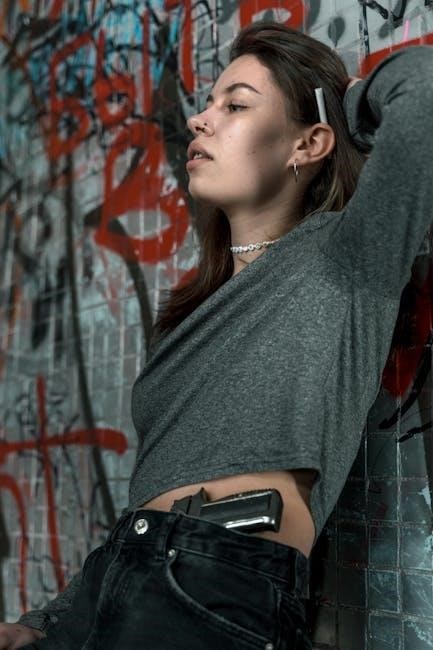
Pain Management and Expectations
When considering an ear piercing‚ understanding the pain involved and how to manage it is essential for a positive experience. While pain is subjective‚ most people describe the sensation as a quick pinch or sting‚ with some piercings being more uncomfortable than others. For example‚ the daith piercing is often cited as one of the most painful due to its location in a sensitive fold of cartilage‚ while lobe piercings are generally less painful.
To manage pain during the procedure‚ it’s important to stay calm and relaxed. Taking deep breaths before and during the piercing can help reduce anxiety and make the process smoother. Some people also find it helpful to distract themselves by focusing on a calming activity or having a friend present for support; Professional piercers often work quickly and efficiently‚ which can make the experience less intimidating.
The choice of piercing jewelry and technique can also influence the level of discomfort. Reputable piercers use high-quality‚ sterile equipment‚ such as hollow needles‚ which are designed to minimize pain and trauma to the tissue. Avoiding piercing guns‚ especially for cartilage piercings‚ is highly recommended‚ as they can cause more discomfort and increase the risk of complications.
After the piercing‚ some mild discomfort‚ swelling‚ or tenderness is normal. This typically subsides within a few days to a week‚ depending on the piercing location. Over-the-counter pain relievers‚ such as ibuprofen‚ can help alleviate any soreness. It’s important to avoid touching or playing with the piercing during the healing process‚ as this can exacerbate discomfort and slow healing.
Setting realistic expectations is key. While the piercing process is relatively quick‚ the aftercare and healing period require patience. By understanding the potential discomfort and taking steps to manage it‚ you can approach your piercing experience with confidence. Remember‚ the temporary sensation of pain is a small trade-off for the long-term enjoyment of your new piercing.
Ultimately‚ the pain associated with ear piercing is temporary‚ and the end result is well worth it. With proper preparation and aftercare‚ you can minimize discomfort and enjoy a seamless experience from start to finish.
Infection Prevention and Treatment
Infection prevention is crucial for maintaining the health and appearance of your ear piercing. Proper aftercare and hygiene practices can significantly reduce the risk of complications. When a piercing is infected‚ it can lead to redness‚ swelling‚ pain‚ and discharge‚ which‚ if left untreated‚ may worsen and prolong the healing process. Understanding how to prevent infections and knowing how to treat them early is essential for a smooth recovery.
The first step in preventing infection is to keep the piercing clean. Gently washing the area with mild soap and warm water daily is recommended. Many piercers also suggest using a saline solution (a mixture of sea salt and distilled water) to clean the piercing‚ as it promotes healing and reduces the risk of bacterial growth. Avoid using harsh chemicals‚ hydrogen peroxide‚ or alcohol‚ as these can irritate the skin and delay healing.
Another key aspect of infection prevention is avoiding touching the piercing unnecessarily. Hands can carry bacteria‚ which can easily transfer to the piercing site. Additionally‚ avoid submerging the piercing in water‚ such as in swimming pools‚ hot tubs‚ or bathtubs‚ until it is fully healed. Tight or poorly fitting jewelry can also irritate the area‚ increasing the risk of infection.
If an infection does occur‚ it’s important to act quickly. Continue with your regular aftercare routine and monitor the area closely. Signs of infection include increased redness‚ swelling‚ warmth‚ or pus around the piercing. If these symptoms persist or worsen‚ consult a healthcare professional for guidance. In some cases‚ antibiotics may be prescribed to treat the infection.
While over-the-counter ointments may seem like a solution‚ they are not always recommended‚ as they can trap bacteria and slow healing. Instead‚ stick to saline soaks or compresses to help draw out any bacteria and reduce inflammation. Never attempt to remove the jewelry yourself‚ as this can cause further irritation and push bacteria deeper into the tissue.
Preventing infections requires consistent effort‚ but the payoff is a healthy‚ attractive piercing. By following proper aftercare‚ avoiding contaminated environments‚ and seeking professional advice when needed‚ you can enjoy your piercing without unnecessary complications.
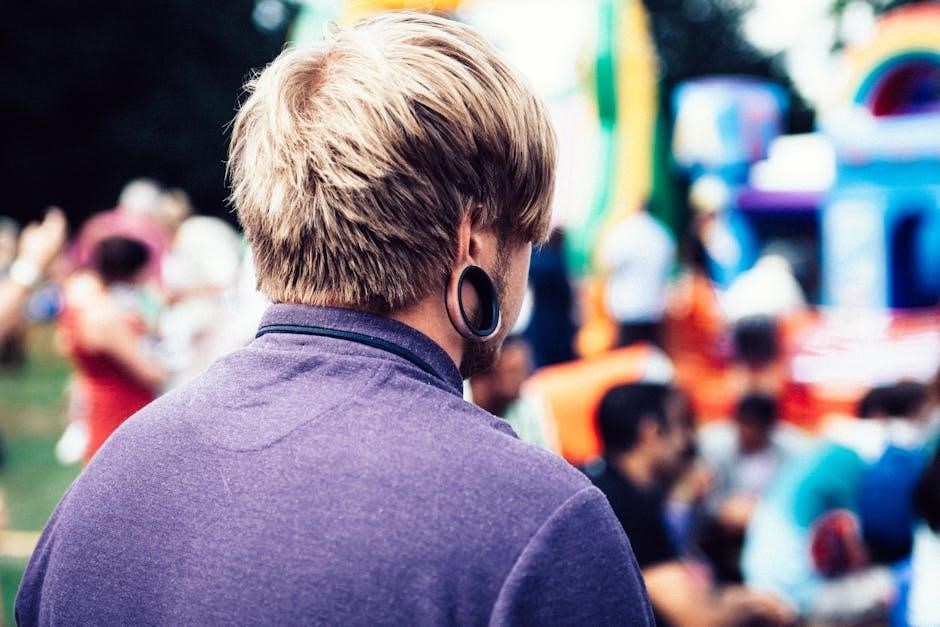
Cost Considerations
When considering an ear piercing‚ one of the key factors to evaluate is the cost. The price can vary significantly depending on several factors‚ including the type of piercing‚ the location‚ and the studio or piercer you choose. It’s important to understand that while some piercings may seem inexpensive upfront‚ the total cost can add up when considering jewelry‚ aftercare products‚ and potential touch-ups.
The cost of an ear piercing typically ranges from $20 to $100 or more‚ depending on the complexity of the piercing and the materials used. For example‚ a standard lobe piercing might be on the lower end of the spectrum‚ while more intricate piercings‚ such as a daith or tragus‚ may cost more due to their delicate nature and the skill required. Additionally‚ some studios charge separately for the piercing and the jewelry‚ while others include both in a package deal.
Jewelry is a significant part of the overall cost. High-quality‚ hypoallergenic materials‚ such as surgical stainless steel or solid gold‚ are recommended for new piercings to minimize the risk of allergic reactions and ensure proper healing. These materials can be more expensive than fashion jewelry‚ but they are worth the investment for long-term comfort and safety. Some studios also offer premium jewelry options‚ which can increase the total cost but provide a more stylish or durable choice.
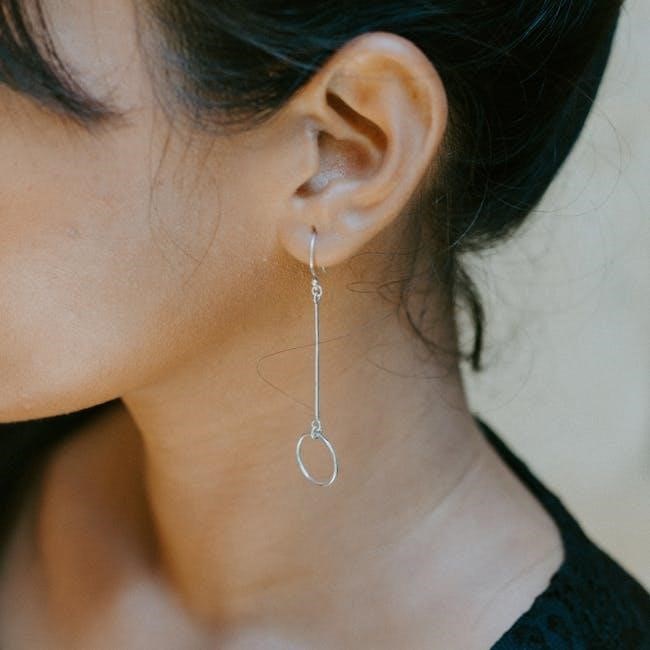
Aftercare products are another expense to consider. While some studios may provide a basic cleaning solution‚ others may recommend or sell specialized aftercare products. These can range in price from $5 to $20‚ depending on the brand and quality. Investing in a good aftercare routine is essential to prevent infections and promote healing‚ so factor this into your budget.
Professional fees can also vary depending on the piercer’s experience and the studio’s reputation. A more experienced piercer may charge higher rates‚ but this often ensures a safer and more precise piercing experience. Be wary of extremely low prices‚ as this could indicate lower-quality materials or less hygienic conditions.
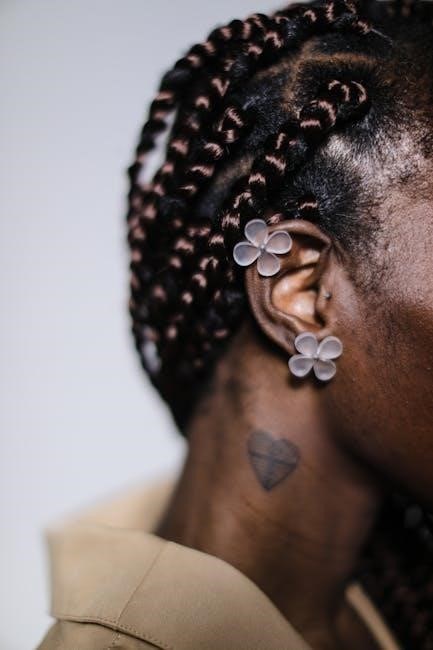
Maintenance and Styling
Maintaining and styling your ear piercings is crucial for both their aesthetic appeal and long-term health. Proper care ensures that your piercings heal well and remain a beautiful part of your personal style. Regular cleaning is essential‚ especially during the healing phase. Gently your piercings with saline solution or mild soap and water to prevent dirt and bacteria buildup.
Once your piercings are fully healed‚ you can explore a wide range of styling options. Jewelry choice plays a significant role in the overall look of your piercings. Opt for high-quality‚ hypoallergenic materials like surgical stainless steel‚ titanium‚ or solid gold to avoid irritation and ensure durability. Hoops‚ studs‚ and dangle earrings are popular choices‚ each offering a unique aesthetic.
Styling your ear piercings can be a fun and creative process. Many people choose to mix and match different types of piercings‚ such as pairing a delicate lobe stud with a bold helix hoop. Layering piercings across the ear can create a cohesive‚ polished look. Consider your personal style and the shape of your face when selecting jewelry to ensure a flattering result.
For those looking to make a statement‚ stacking multiple piercings on one ear or experimenting with asymmetrical designs can add visual interest. Stylists often recommend balancing bold pieces with simpler ones to avoid overwhelming the look. Accessories like cuffs or wraps can also be added to enhance the overall aesthetic.
Maintenance goes beyond cleaning; it also involves checking jewelry regularly to ensure it is secure and properly fitted. Tightening screws or adjusting hoops periodically can prevent accidental loss. When changing jewelry‚ always use clean‚ sterilized pieces to minimize the risk of irritation or infection.
Lastly‚ consider consulting a professional piercer for styling advice tailored to your preferences and ear structure. They can help you choose jewelry that complements your unique features and provide tips for maintaining your piercings. With proper care and creative styling‚ your ear piercings can become a stunning expression of your individuality.
As outlined in this guide‚ proper care and maintenance are key to ensuring your piercings remain healthy and visually appealing. By understanding the healing process‚ choosing appropriate jewelry‚ and following aftercare routines‚ you can enjoy your piercings for years to come. Additionally‚ the continuous evolution of piercing trends offers endless inspiration for those looking to experiment with new styles.
Ear piercings have transcended traditional norms‚ becoming a celebrated form of self-expression. They no longer carry the same rebellious connotations they once did‚ instead symbolizing personal freedom and creativity. Whether you’re considering a first-time piercing or expanding your collection‚ the journey can be both empowering and enjoyable.
Remember‚ consulting a professional piercer is essential for a safe and satisfying experience. Their expertise can guide you in selecting the right piercings and jewelry to suit your preferences and ear anatomy. With the right approach‚ ear piercings can be a beautiful and lasting addition to your personal style.